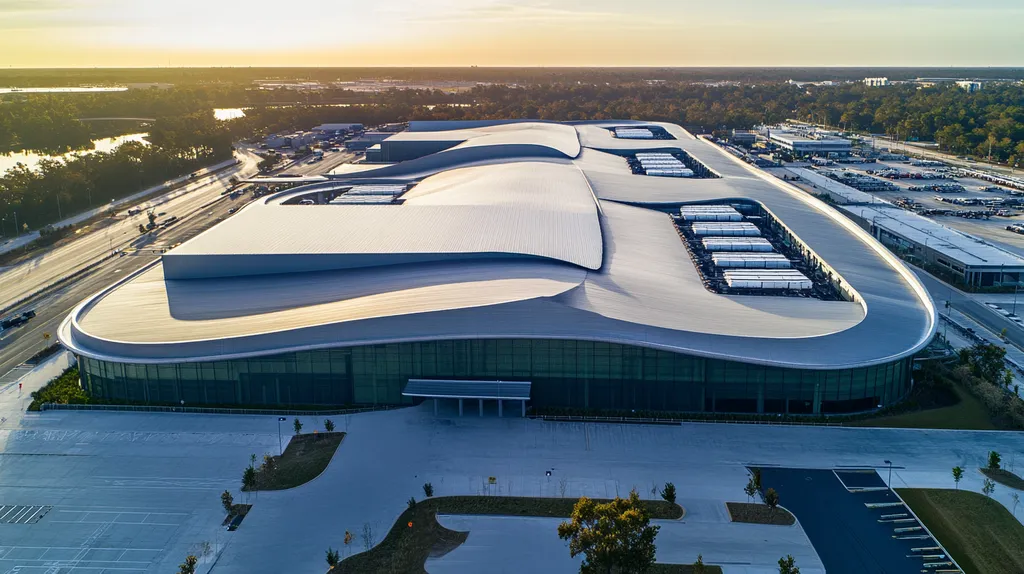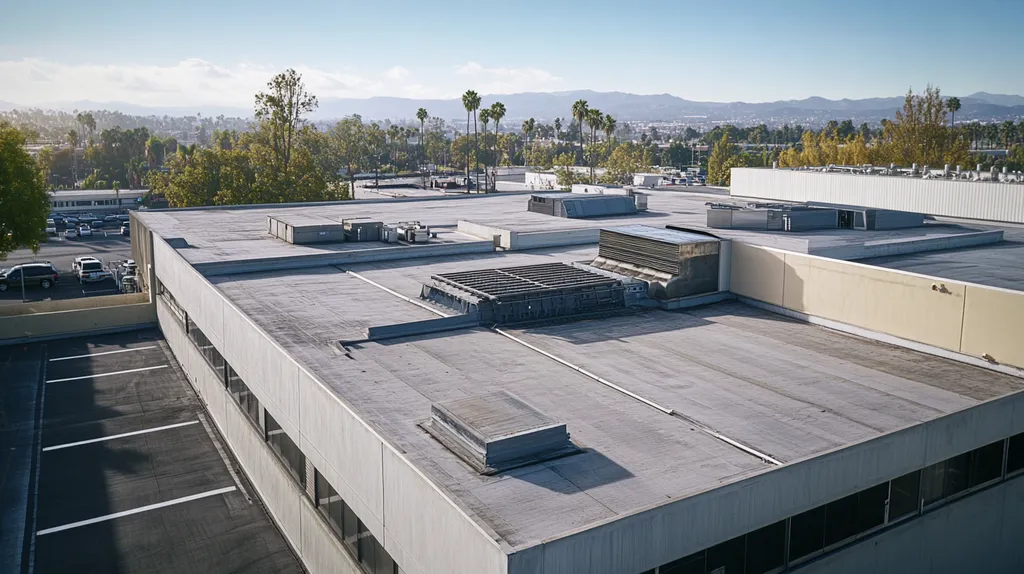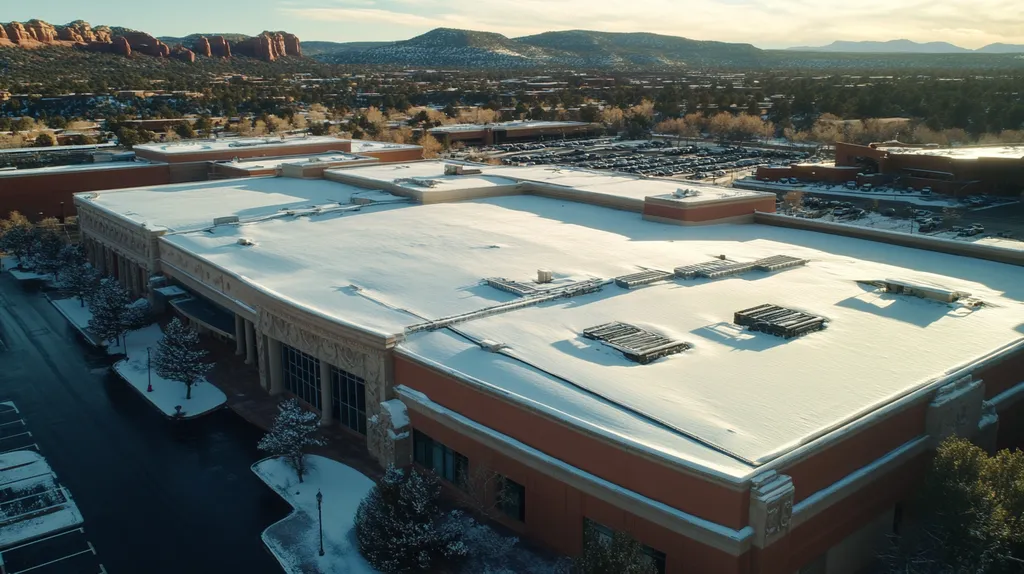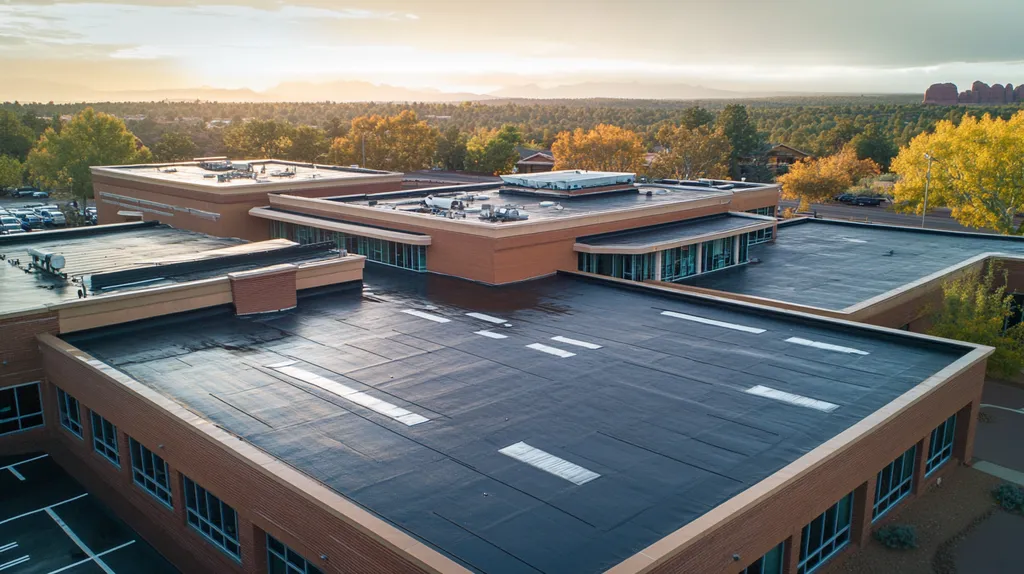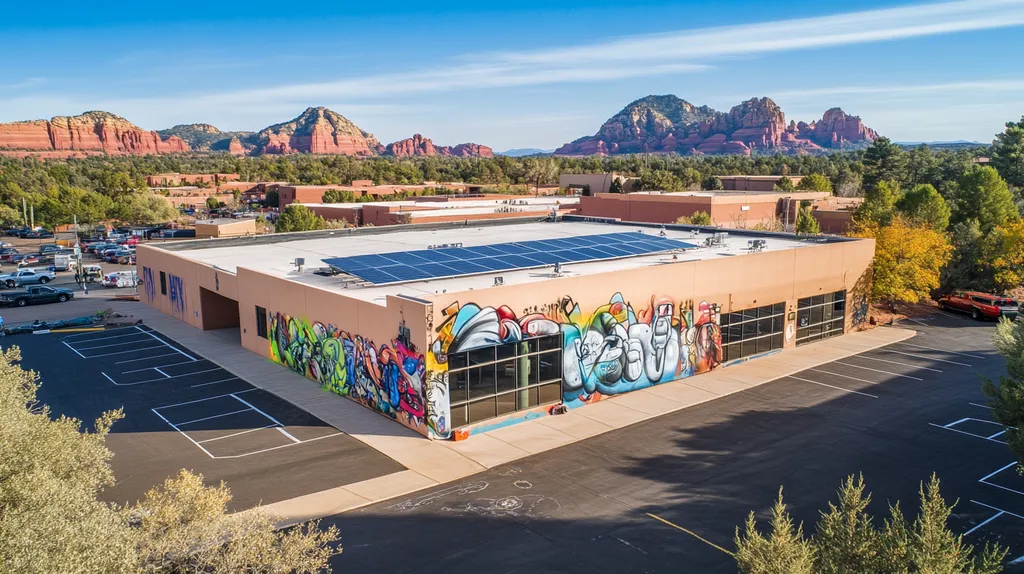Welcome to today’s Battle Royale featuring two roofing heavyweights: “TPO” in the east corner versus “EPDM” in the west!
Tonight’s showdown pits these contenders against each other across six punishing rounds designed to test every aspect of their performance for flat vs. pitched commercial roof warranty.
At stake? Millions in potential costs, decades of building protection, and the critical performance demands of modern commercial and industrial facilities.
Our professional judging panel will evaluate each round on technical merit, real-world performance, and value delivery. After all six rounds, we’ll declare our ultimate champion.
Ladies and gentlemen, facility managers and building owners… it’s time to rumble!
ROUND 1: INITIAL COSTS & INSTALLATION
When selecting between TPO and EPDM roofing systems, the initial investment shapes both immediate budget impacts and long-term financial outcomes. Making the wrong choice can lead to premature system failure, unexpected maintenance costs, and business disruptions that could have been avoided with proper planning.
Understanding the complete cost picture – from materials to installation complexity to project duration – is essential for making an informed decision that aligns with both immediate budget constraints and long-term facility goals.
Material Expenses
Material costs form the foundation of any roofing project’s budget. TPO membrane typically costs 15-25% less per square foot than EPDM, making it particularly attractive for large-scale commercial installations.
EPDM’s higher material cost is often offset by its exceptional durability and simpler installation requirements. The material’s proven track record of lasting 25-30 years in varied climates makes it a compelling long-term investment.
When considering warranties, GAF’s unique Steep Slope Addendum for their Diamond Pledge NDL Roof Guarantee offers coverage for both flat and sloped areas, adding significant value to either material choice. (source: GAF)
For pure material cost comparison, TPO claims the “ADVANTAGE” due to its lower upfront expense.
Installation Complexity
Installation complexity directly impacts labor costs and project success rates. TPO requires specialized heat-welding equipment and highly trained installers to ensure proper seam fusion and membrane attachment.
The technical demands of TPO installation can limit contractor availability and increase labor costs, especially in regions where skilled TPO installers are scarce. Even minor installation errors can compromise the entire system’s integrity.
EPDM installation involves more straightforward techniques, requiring less specialized equipment and training. This simplicity reduces the risk of installation errors and expands the pool of qualified contractors.
Based on installation requirements, EPDM takes the “ADVANTAGE” for its more accessible installation process.
Project Timeline
Project duration significantly impacts facility operations and overall costs. TPO installations typically require more time due to the precise nature of heat-welded seams and weather-dependent installation conditions.
Weather sensitivity can extend TPO installation timelines, as proper heat-welding requires specific temperature and humidity conditions. These constraints can lead to unexpected delays and scheduling challenges.
EPDM installations generally progress more quickly due to simpler application methods and fewer weather restrictions. This efficiency minimizes business disruption and allows faster project completion.
Considering timeline efficiency, EPDM earns the “ADVANTAGE” for its more predictable and typically shorter installation period.
ROUND 1 WINNER: EPDM
ROUND 2: DURABILITY & LIFESPAN
Understanding material durability and lifespan is crucial when selecting a commercial roofing system, as premature failure can cost businesses millions in repairs and lost productivity. Modern roofing materials offer vastly different performance characteristics, with expected lifespans ranging from 15 to over 50 years depending on the system chosen.
The stakes are particularly high for facilities operating sensitive equipment or maintaining strict environmental controls, where roof failure can cascade into catastrophic business interruptions. Making an informed choice between TPO and EPDM requires careful evaluation of each system’s long-term performance capabilities.
Weather Resistance
TPO membranes excel in UV resistance and maintain their reflective properties effectively over time. Their heat-welded seams create a monolithic surface that resists water penetration and chemical exposure.
However, TPO can become brittle in extreme temperature conditions, potentially leading to cracking or separation at the seams. This vulnerability becomes more pronounced as the material ages, particularly in climates with dramatic temperature swings.
EPDM demonstrates superior flexibility across extreme temperature ranges, maintaining its elasticity from -40°F to 300°F. This natural rubber compound resists cracking and splitting even after decades of exposure.
The material’s molecular structure allows it to expand and contract without compromising its integrity, making it particularly effective in regions with variable weather patterns.
Based on overall weather resistance, EPDM claims the “ADVANTAGE” due to its superior flexibility and temperature tolerance.
Physical Durability
TPO offers good resistance to tears and punctures, particularly in newer formulations. The material’s reinforced construction helps it withstand moderate impact and foot traffic during routine maintenance.
The membrane’s thickness options, typically ranging from 45 to 80 mil, allow customization based on anticipated wear patterns. However, aging TPO can become more susceptible to physical damage.
EPDM provides exceptional resistance to impact damage and maintains its physical properties longer than TPO. Its rubber composition naturally absorbs impacts that might damage other materials.
The material’s tear resistance actually improves with age as it cures fully, contributing to its longer service life. This characteristic is particularly valuable in areas prone to hail or requiring frequent maintenance access.
For physical durability, EPDM takes the “ADVANTAGE” through superior long-term performance.
Warranty Coverage
TPO systems typically come with warranties ranging from 15 to 20 years, reflecting manufacturers’ confidence in the material’s service life. Coverage often includes provisions for maintaining the membrane’s reflective properties.
While these warranties offer solid protection, they may require more frequent inspections and maintenance documentation to remain valid. This increased oversight adds to the total cost of ownership.
EPDM warranties commonly extend to 30 years or more, demonstrating the material’s proven longevity. Many manufacturers offer enhanced coverage options that include both materials and workmanship guarantees.
The comprehensive nature of EPDM warranties provides superior protection against potential issues, allowing for more predictable long-term budget planning. EPDM claims the “ADVANTAGE” in warranty coverage.
ROUND 2 WINNER: EPDM
ROUND 3: PERFORMANCE FACTORS
The performance characteristics of commercial roofing systems directly impact both warranty coverage and long-term facility costs. With increasingly extreme weather patterns and rising energy costs, choosing between TPO and EPDM has never been more critical for property owners.
Understanding how each system performs across key metrics – from UV resistance to maintenance demands – is essential for making decisions that protect both the facility and bottom line.
Performance Reliability
TPO membranes deliver exceptional UV resistance and maintain their reflective properties throughout their service life. Their heat-welded seams create a monolithic surface that effectively resists water infiltration and chemical exposure.
However, TPO can become brittle in extreme temperature conditions, particularly in climates with dramatic temperature fluctuations. This vulnerability becomes more pronounced as the material ages.
EPDM demonstrates remarkable flexibility across extreme temperature ranges, maintaining its elasticity from -40°F to 300°F. Its molecular structure allows for natural expansion and contraction without compromising structural integrity.
For overall performance reliability, EPDM claims the “ADVANTAGE” due to its superior temperature tolerance and proven track record.
Maintenance Requirements
TPO roofing systems typically require minimal routine maintenance beyond regular inspections. Their smooth surface naturally resists dirt accumulation and biological growth, reducing cleaning requirements.
Material warranties for TPO systems range from 10-30 years, though premium installations can extend coverage up to 50 years with proper maintenance documentation. (source: GIDEON)
EPDM systems demand more frequent inspections and maintenance, particularly around seams and penetrations. While the material itself is durable, its surface texture can trap debris and require more regular cleaning.
Based on maintenance demands, TPO takes the “ADVANTAGE” for its lower maintenance requirements and simplified upkeep protocols.
Environmental Impact
TPO’s highly reflective surface significantly reduces cooling costs and urban heat island effects. Modern formulations maintain these reflective properties throughout the membrane’s service life, contributing to sustained energy savings.
The material’s recyclability and minimal chemical off-gassing during installation make it an environmentally responsible choice. These characteristics help facilities meet green building certification requirements.
EPDM offers excellent durability but absorbs more solar heat than TPO. While the material can be recycled at end-of-life, its dark surface increases cooling demands and energy consumption during summer months.
Considering environmental factors, TPO earns the “ADVANTAGE” through superior energy efficiency and sustainable characteristics.
ROUND 3 WINNER: TPO
ROUND 4: MAINTENANCE REQUIREMENTS
Proper maintenance of commercial roofing systems directly impacts warranty coverage, energy efficiency, and long-term facility costs. With modern roofing warranties requiring strict maintenance documentation, understanding the specific requirements for TPO and EPDM systems has become crucial for protecting both the initial investment and ongoing operations.
The stakes are particularly high for facilities where roof failure could compromise sensitive equipment or disrupt critical business operations. Making an informed choice between TPO and EPDM maintenance protocols requires careful evaluation of each system’s specific demands and long-term care requirements.
Regular Inspection Requirements
TPO roofing systems demand thorough bi-annual inspections focused on seam integrity and surface condition. These inspections must specifically evaluate heat-welded joints and membrane attachment points, where system failures typically begin.
Professional inspection services are often required for TPO systems, as identifying potential issues requires specialized knowledge of heat-welded seam degradation patterns. This expertise requirement can increase long-term maintenance costs.
EPDM systems generally require less frequent professional inspections, with many issues identifiable through basic visual assessment. The material’s simple construction and fewer failure points make routine evaluations more straightforward.
For inspection requirements, EPDM claims the “ADVANTAGE” due to its simpler evaluation needs.
Repair Protocols
TPO repairs typically require specialized equipment and certified technicians to maintain warranty coverage. Even minor repairs must follow strict manufacturer guidelines to ensure proper heat-welding of patches and seams.
The technical nature of TPO repairs often results in higher service costs and longer response times when issues arise. This complexity can lead to extended facility disruptions during maintenance periods.
EPDM repairs can often be completed using standard tools and materials, with many maintenance tasks manageable by trained facility staff. The material’s natural flexibility and simple seaming requirements simplify both minor repairs and major restoration work.
Based on repair accessibility, EPDM takes the “ADVANTAGE” through more straightforward maintenance procedures.
Warranty Compliance
GAF’s Diamond Pledge NDL Roof Guarantee offers comprehensive coverage for properly maintained commercial roofing systems, with options extending up to 35 years. Their warranties include unlimited dollar amount coverage for repairs and can transfer to subsequent property owners. (source: GAF)
TPO systems require strict adherence to manufacturer-specified maintenance schedules and documentation protocols. Missing or inadequate maintenance records can void warranty coverage, leaving facility owners exposed to unexpected repair costs.
EPDM systems typically offer more flexible maintenance requirements while maintaining warranty protection. The material’s proven durability and simpler care needs result in fewer warranty compliance challenges.
Considering warranty maintenance requirements, EPDM earns the “ADVANTAGE” through more manageable compliance protocols.
ROUND 4 WINNER: EPDM
ROUND 5: SUSTAINABILITY CREDENTIALS
As commercial buildings face increasing pressure to reduce their environmental impact, roofing choices have become critical sustainability decisions. Modern roofing systems can dramatically affect a building’s carbon footprint, energy consumption, and waste generation throughout their lifecycle.
With many jurisdictions implementing strict environmental regulations and sustainability requirements, selecting the right roofing system has implications far beyond immediate performance considerations. The stakes are particularly high for facilities seeking green building certifications or facing mandatory emissions reduction targets.
Environmental Impact
TPO roofing systems demonstrate exceptional environmental performance through their highly reflective surface properties. These reflective characteristics significantly reduce cooling loads and help combat urban heat island effects, particularly in densely developed areas.
The material’s manufacturing process requires less energy compared to traditional roofing materials, and modern TPO formulations minimize harmful chemical emissions during production and installation. This reduced carbon footprint extends throughout the product’s lifecycle.
EPDM systems, while durable, typically absorb more solar radiation due to their dark coloring. This heat absorption increases cooling requirements and energy consumption, particularly during peak summer months.
While EPDM’s longevity contributes to resource conservation, its overall environmental impact remains higher due to increased energy demands. For environmental performance, TPO claims the “ADVANTAGE” through superior energy efficiency.
Material Recyclability
TPO membranes are fully recyclable at the end of their service life, with established recycling programs available in most regions. The material can be processed into new roofing products or repurposed for other applications, reducing landfill impact.
Manufacturing processes for TPO increasingly incorporate recycled content, creating a more circular material lifecycle. This commitment to recyclability aligns with growing corporate sustainability initiatives.
EPDM offers limited recycling options, with most materials ultimately destined for landfills. While some manufacturers have implemented take-back programs, the infrastructure for EPDM recycling remains less developed.
Considering material recyclability, TPO earns the “ADVANTAGE” through superior end-of-life options.
Energy Performance
TPO’s reflective properties deliver measurable energy savings throughout the system’s lifespan. Modern formulations maintain their reflective characteristics even after years of exposure, ensuring consistent performance.
The material’s ability to reflect solar radiation reduces cooling loads by up to 30% in warm climates, directly impacting facility operating costs and carbon emissions. This performance helps buildings meet increasingly stringent energy codes.
EPDM systems, particularly in dark colors, absorb significant solar radiation. While this can be beneficial in cold climates, it typically increases overall energy consumption and associated carbon emissions in most commercial applications.
For energy performance, TPO takes the “ADVANTAGE” through consistent energy-saving characteristics.
ROUND 5 WINNER: TPO
ROUND 6: SPECIALIZED APPLICATIONS
Specialized commercial roofing applications present unique warranty challenges that can make or break a facility’s long-term viability. From rooftop equipment installations to green roof systems, choosing the wrong material can void coverage and lead to catastrophic repair costs.
Understanding how TPO and EPDM warranties respond to specialized needs has become crucial as commercial buildings evolve beyond simple weather protection into complex environmental management systems.
Environmental Considerations
TPO systems excel in high-UV environments, with warranties specifically covering reflectivity retention and UV resistance. Their heat-welded seams create exceptional protection against chemical exposure and industrial emissions.
These systems show particular strength in environments with extreme temperature fluctuations, though warranty coverage may be limited in areas with high chemical exposure or extreme heat conditions.
EPDM demonstrates superior performance in environments with frequent thermal cycling and exposure to industrial chemicals. The material’s natural flexibility and resistance to environmental degradation often result in extended warranty terms.
For environmental adaptability and warranty coverage, EPDM claims the “ADVANTAGE” through superior chemical resistance and thermal stability.
Equipment Integration
TPO systems offer robust support for rooftop equipment installations, with warranties specifically addressing penetrations and equipment mounting requirements. Their reinforced construction helps maintain integrity around mechanical systems and support structures.
However, warranty coverage often requires specialized installation protocols and regular inspections around equipment mounting points. This increased oversight can add to long-term maintenance costs.
EPDM provides more flexible warranty terms for equipment integration, with fewer restrictions on mounting methods and penetration types. The material’s natural elasticity helps maintain seals around equipment supports without compromising warranty coverage.
Considering equipment integration requirements, EPDM takes the “ADVANTAGE” through more adaptable warranty terms.
Special Usage Requirements
TPO warranties typically offer comprehensive coverage for high-traffic areas and specialized usage patterns. Manufacturers specifically address scenarios like regular maintenance access and equipment servicing in their warranty terms.
Warranties for pitched roof sections often extend up to 50 years for architectural shingles, with coverage varying based on material quality and installation requirements. (source: Brexteriors)
EPDM systems provide more limited warranty coverage for specialized uses, often requiring additional documentation and maintenance protocols. While the material performs well, warranty terms may restrict certain applications.
For special usage requirements, TPO earns the “ADVANTAGE” through more comprehensive warranty coverage.
ROUND 6 WINNER: TPO
AND THE WINNER IS…
After six grueling rounds of technical evaluation, we have our verdict…
In a split decision, with EPDM claiming four rounds to TPO’s two, the heavyweight championship belt goes to EPDM roofing systems!
EPDM dominated the early rounds with superior durability, simplified installation protocols, and comprehensive warranty coverage. Its knockout performance in maintenance requirements and physical resilience sealed the victory.
But don’t count TPO out! This formidable challenger showed incredible strength in sustainability and specialized applications. For facilities prioritizing energy efficiency or requiring extensive equipment integration, TPO remains a compelling choice.
Important Notice: Every building presents unique challenges that can impact roofing performance. Local climate conditions, building usage patterns, and specific structural requirements all play crucial roles in system selection. This analysis provides general guidance but cannot account for all variables. Property owners should consult with qualified roofing professionals who can evaluate their specific situation before making final decisions.
Ladies and gentlemen, in the high-stakes world of commercial roofing, there’s no substitute for informed decision-making. The true champion isn’t just the material you choose – it’s finding the perfect match between your facility’s needs and your roofing system’s strengths. Choose wisely, and may your warranty coverage remain ever strong!
FREQUENTLY ASKED QUESTIONS
Q. What are the initial costs for a commercial roof with TPO or EPDM?
A. The initial costs for TPO are typically 15-25% lower than EPDM. However, EPDM may offer long-term value due to its durability and lifespan, which can lead to cost savings over time. It’s essential to evaluate both upfront expenses and lifetime value when selecting a roofing material.
Q. How do TPO and EPDM compare in durability for commercial roofs?
A. While TPO performs well in UV resistance, EPDM excels in flexibility and temperature tolerance. EPDM’s longevity can outlast TPO, particularly in regions with extreme weather. Each material has unique properties that should align with your facility’s specific needs for durability.
Q. Which roofing material performs better under extreme conditions?
A. EPDM is known for its flexibility across extreme temperatures, maintaining integrity without cracking. In contrast, TPO may become brittle in extreme conditions. Thus, for harsh climates, EPDM is typically the superior choice, offering better performance and longevity.
Q. What are the maintenance requirements for a commercial roof?
A. TPO roofs require bi-annual inspections focusing on seams and surface condition. EPDM roofs involve slightly simpler maintenance, allowing for basic visual assessments. Understanding these requirements can help ensure long-term durability and preserve warranty coverage.
Q. Which roofing option is more sustainable in the long run?
A. TPO’s reflective surface significantly reduces cooling costs, making it more energy-efficient. It also offers better recyclability at the end of its lifecycle. In contrast, EPDM, while durable, has a larger carbon footprint due to its heat absorption properties.
Q. How do warranties differ for TPO and EPDM roofing systems?
A. TPO warranties typically range from 15 to 20 years, while EPDM warranties can reach up to 30 years or more. EPDM often includes enhanced coverage options, providing more long-term security for facility owners regarding potential issues.
Q. What specialized applications should I consider for my industrial roof?
A. For rooftop equipment or green systems, consider TPO for its robust support and warranty adaptability. EPDM is great for environments with high thermal cycling or chemical exposure. Select material based on specific operational needs to maximize warranty effectiveness.

